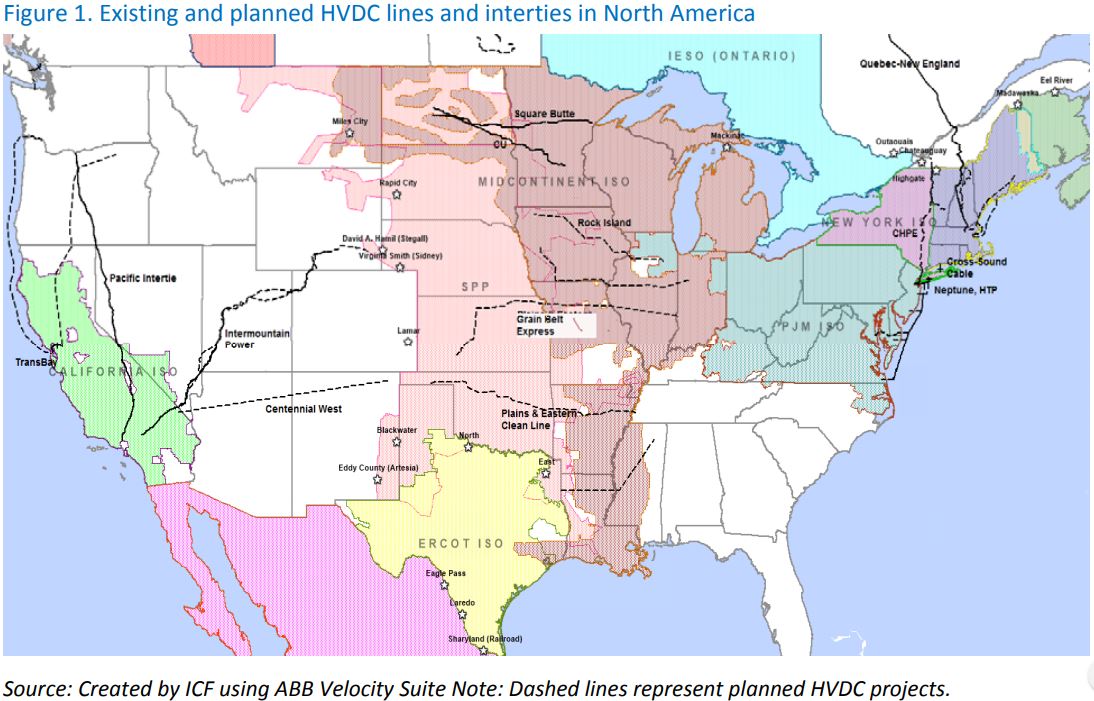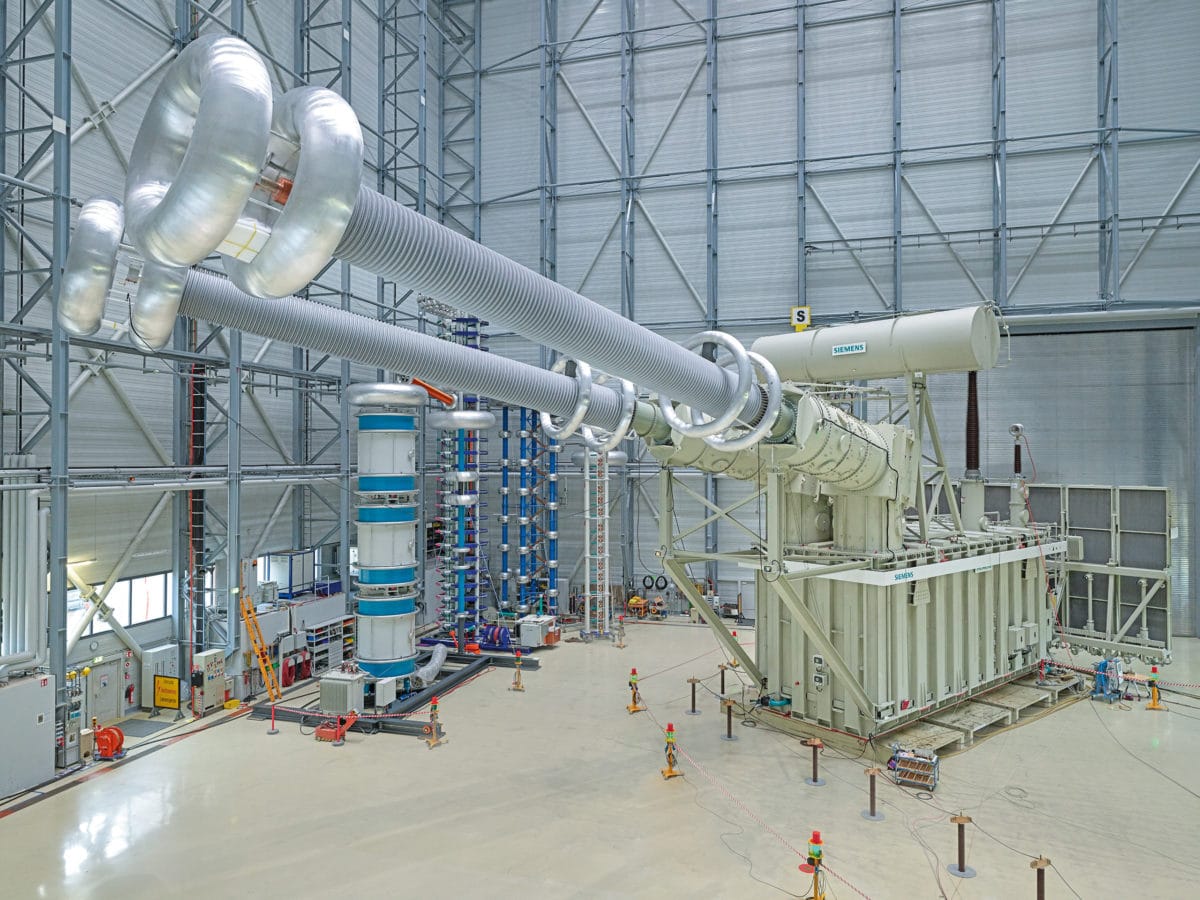High Voltage Direct Current (HVDC) has been talked about for almost 100 years now. The first patents were filed in Sweden in 1929, the first demonstration lines were built in the Soviet Union in 1951, and the first real line was built in 1954 in Sweden to connect an island to the mainland. Today, its moving on to the next generations of hardware to move wind and solar. This hardware from Siemens is the first out of seven transformers of this type that Siemens will deliver for the world’s largest HVDC project in China, which will transmit 12 GW over a distance of 3,284 kilometers.
Research suggests that in the United States a nationwide HVDC network could enable the nation to reach 100% electricity from wind+solar (along with some energy storage) in certain deployment models, and without this we’d need 12 hours of energy storage to get to 80% wind+solar. The U.S. Department of Energy’s (DOE) National Renewable Energy Laboratories (NREL) has also considered 30% wind+solar on the East US seaboard, and saw six HVDC lines as meeting the broader needs of grid stability.

As the latest in this research, the DOE’s Energy Information Administration (EIA) has published HVDC and Non‐Dispatchable Generation, looking broadly at how HVDC has been installed in the United States and the main challenges (cost, complexity and rights of way) holding it back.
There are significant benefits to HVDC, including superior economics for long-distance transmission of electricity, lower reactive and ‘skin effect’ losses and lower losses overall – 3.5% per 1000 km versus 6.7%. The technology also runs into fewer right of way conflicts as the hardware is smaller, and suitable for underwater applications, high capacity ratings, longer overload capacity, and greater ability to handle line instability.
Those technical advantages translate to the promise of being able to efficiently move wind power from the wind-heavy, lightly populated Midwest to East Coast population centers. Additionally solar power, can be ‘time shifted’ forward or backwards from 12 noon toward the east or west, or it can simply be shipped north to areas with fewer solar resources.
The most glaring drawback is cost, specifically for shorter distances, with a disadvantage for lines under 60 miles for a submarine line, or 200 miles for overhead. Along with this is more complex hardware, and in the areas between expensive and complex ‘conversion stations’ there is no ability to tap into the electricity. Table 4, page 33 of 74 from the PDF, breaks down the specific costs of an HVDC project.
The per-mile cost of HVDC projects ranges between $1.17 million and $8.62 million, according to a review of recent proposals and relevant regulatory filings.
Multiple case studies were presented in the analysis. The Midcontinent Independent System Operator (MISO) did an analysis in 2014 that considered interconnecting the three main US power grids: the Eastern Interconnection, Western Interconnection and Texas’ ERCOT. This study found significant broad benefits including improved frequency control, the ability to manage load across a broad network and make better use of spare capacity, as well as sharing the output of wind and solar power across broad regions.

The estimated value of such a system would be: $45.3 billion, with benefits accruing due to load diversity ($21 billion), frequency response ($9.8 billion), wind diversity ($2.2 billion), and other energy benefits ($12.2 billion). The system costs would be $36.2 billion.
HVDC might be a significant support for deploying solar+wind across the United States, at a lower cost than other technologies. However, further industry scaling must occur, and certain technology challenges must be overcome.
But those are not the biggest challenges. We must still, as a nation of individual land owners, learn to accept the use of land for nationwide power infrastructure. And last but not least: we need to reverse a multi-decade long-trend and begin to invest in our national infrastructure, something which is as complex a political maneuver in our current atmosphere as it is to build the HVDC network itself.
This content is protected by copyright and may not be reused. If you want to cooperate with us and would like to reuse some of our content, please contact: editors@pv-magazine.com.









Such concentrated reliance on transmission, while a powerful method, is very vulnerable to sabotage and security concerns, and draws funding away from communities and areas who could reduce the required demand for this by employing storage with solar in the distribution network.
I agree. This story – https://pv-magazine-usa.com/2018/03/01/12-hours-energy-storage-80-percent-wind-solar/ – covers a whole bunch of breakdowns of solar+wind+storage+HVDC. We don’t neeeeed HVDC to get to 100% clean energy – but if we have just a little bit it cuts down the total storage needed by quite a bit. I think we could get to 100% wind+solar with 12 hours of storage and just a bit of HVDC.